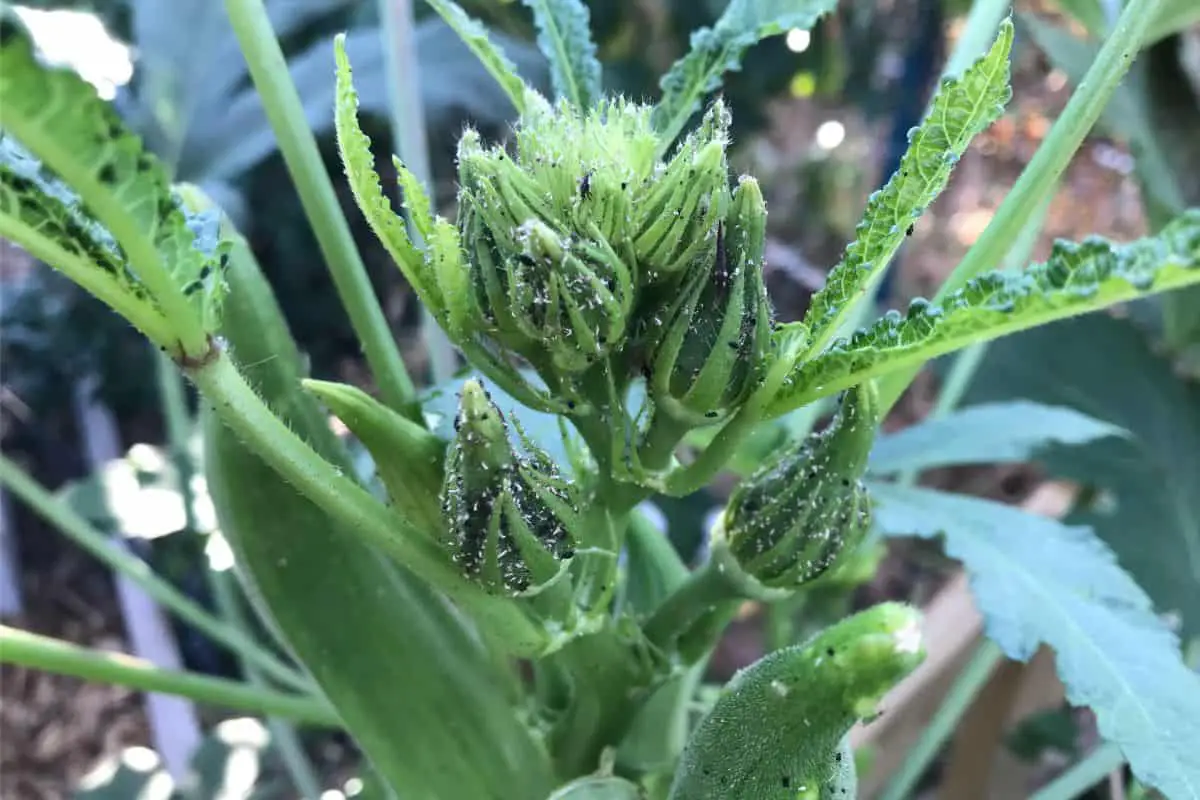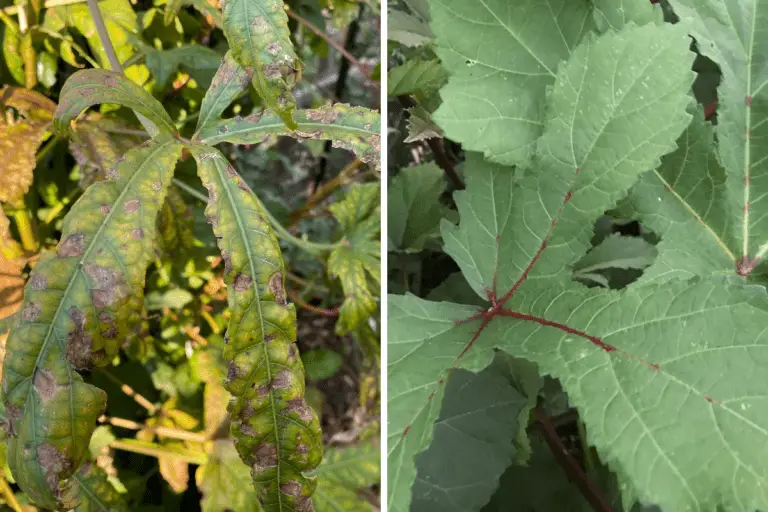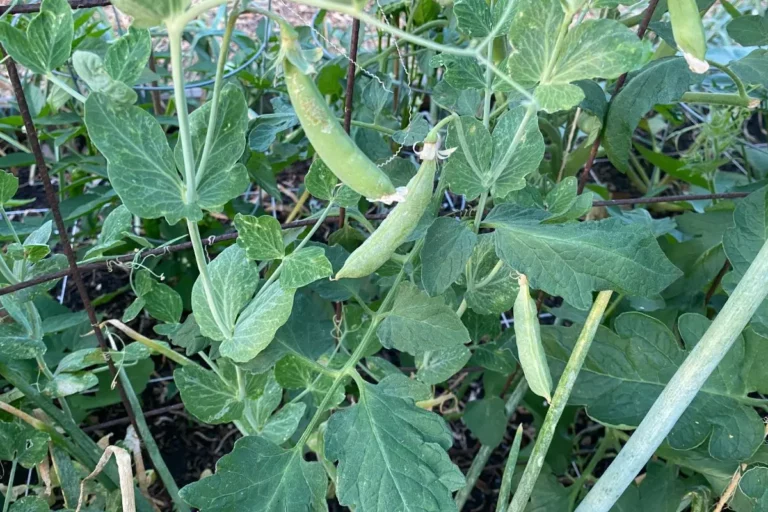Getting Rid of Aphids on Okra: 11 Things You Should Do
Whether you’re new to growing your own okra plants or you’ve been growing them for years, at some point in time, you’ve probably seen tiny specks clustered around the plants’ leaves, buds, or flowers.
For beginning gardeners (like I was 10 or so years ago), it’s easy to ignore or overlook those specks. I certainly did, and I was surprised when, 4-6 weeks after those specks showed up, my okra started looking a little crummy.
But experienced gardeners know exactly what those specks are: aphids.
The most effective way to get rid of aphids on okra is to spray the plants regularly with soapy water and neem oil sprays, taking care not to harm any beneficial predators. Soapy water will choke and kill off aphids, while neem oil, when ingested, will cause all sorts of biological problems.
Aphids come in a variety of sizes and colors–black, green, red, yellow, and white, to name a few–and they’ll arrive on your okra in search of nutrients. They’ll invade your garden and spread from plant to plant.
What they’re looking to do is suck the nutrients (known as phloem sap) right out of your plants, then reproduce and move on once they’ve destroyed their host plant.
The good news? You can see aphids on your plants rather easily if you know what you’re looking for.
The bad news? They’re not necessarily going to disappear when cold weather arrives. Once the wintry months are here, they’ll do these 3 things to stay alive through winter, so you need to stop them now while you have the chance.
In this article, I’ll share several things you can do to keep aphids out of your okra. I’ll focus on two different approaches:
- Proactive Approaches: These are thing you should do before aphids arrive to make your okra less hospitable to these little pests.
- Reactive Approaches: These are things you should do after you’ve noticed aphids among your plants.
If you follow the instructions below–as well as learning about the ways aphids damage plants and what you can do to help your plants recover–you’ll be more than ready to stop an aphid infestation before it destroys your plants.
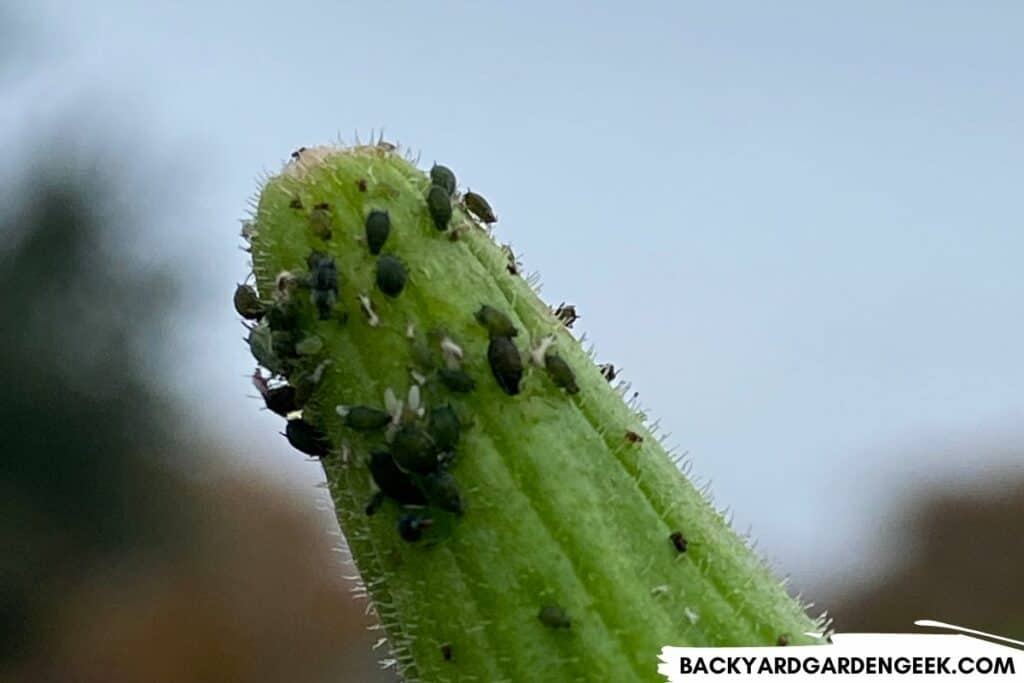
Get Rid of Aphids on Okra: Do This Before Aphids Arrive
Now that you’ve got access to all kinds of resources about aphids, let’s talk about the primary methods I use to get rid of aphids on my okra plants.
I’ll also share some other methods that are proven to work, even if I don’t personally use them anymore because they’re not my preferred approach. That way, you’ll have plenty of options to choose from
1. Mulch Heavily
I did an experiment last year with some plants. I had just built 2 new raised beds, using the same soil in each and planting several homegrown tomato seedlings in both beds. In one bed, I mulched the plants heavily. In the other bed, I didn’t put down any mulch at all.
I was amazed by what happened next. Within a month, the plants in the mulched bed were nearly 50% taller than those in the beds with no mulch. They looked healthier too.
Simply put, mulch keeps your soil nice and moist while simultaneously blocking weed growth. If you want your okra plants to be as healthy as possible, mulch heavily around them using wood chips (my preferred method), chopped up leaves, compost, or even bags of mulch you’ve purchased at your local garden center.
Straw will work too, but I’d avoid hay since you’ll likely end up with lots of weed seeds if you use it around your plants.
2. Water Properly
Aphids love nothing more than to find stressed out plants that aren’t in the best condition when it comes to standing up against pest infestations.
Once they arrive, aphids will attract ants to your okra, which will then make the aphid infestation worse.
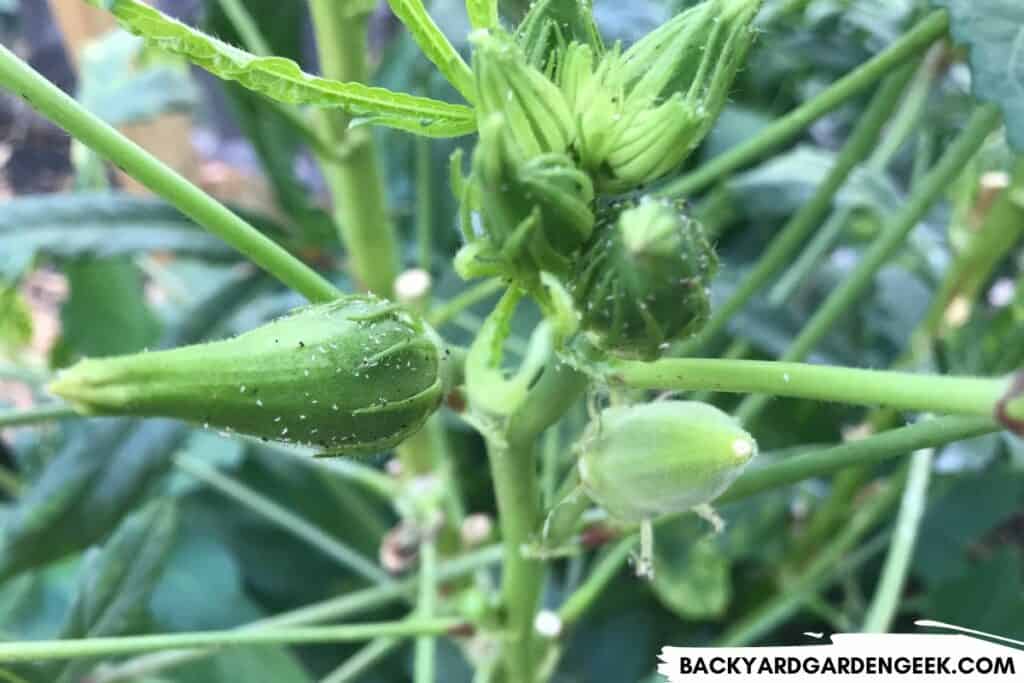
Proper watering won’t magically keep aphids out of your garden–or other pests for that matter–but improper watering is definitely to blame for giving invasive pests the conditions they need to thrive.
Make sure you’re watering regularly, preferably slow and deep. You don’t want to over-water your plants, but you want the soil to be evenly moist.
Don’t be fooled: If the top inch of soil is dry, that doesn’t mean the soil’s dry 6 inches below the surface. Buy a good moisture meter to know for sure!
3. Fertilize as Needed
Here’s the thing about plant fertilization: You have absolutely no idea what your plants need unless you know what your soil is lacking.
Get in touch with your local extension office and order a soil test. They usually cost around $20-30, and they’ll provide you with a wealth of information about your soil.
Generally speaking, okra plants enjoy more balanced fertilizers, such as the 10-10-10 NPK ratio products you can get at local garden centers.
I’ve found that my plants often benefit from Alaska Fish Emulsion. It’s a 5-1-1 solution, which means it’s got enough nitrogen to give plants a little boost but not too much to overwhelm them.
But it’s best to learn as much as possible about your soil first. You’ll then know which fertilizers you need to purchase to give your plants the nutrients they need most.
4. Space Out Your Plants
Aphids love all kinds of plants, so do you know what will happen if you plant all of those plants right next to each other? You might just make it easier for them to migrate from one plant to the next.
Instead of planting all of your okra side by side in your garden, I recommend planting 1/2 of your okra in one bed, then 1/2 in another bed that isn’t adjacent to the first.
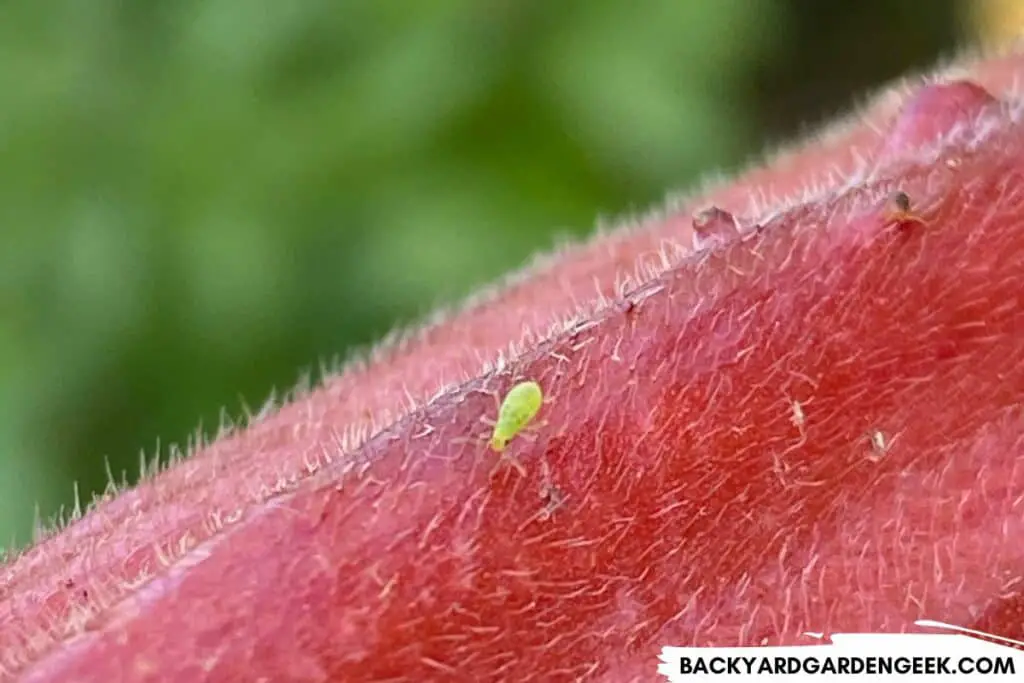
Long story short, it’s perfectly fine to plant all of your okra right next to each other, but you’ll make it easier for aphids to spread from plant to plant if you plant the same kinds of plants together in your garden.
5. Plant Companion Crops
Aphids love all kinds of plants, but there are actually several plants that aphids don’t seem to care for in my experience:
- Catnip
- Cilantro
- Dill
- Fennel
- Garlic
- Lavender
- Leeks
- Marigolds
- Mint
- Onions
I’ve heard some people report that aphids attacked their basil, but I’ve never had that issue personally, so I’ve planted it near my okra on numerous occasions (and included it in the list above). And I’ve grown dill, garlic, marigolds, and onions around my okra plants for years as well.
I like marigolds in particular because they look nice, aphids don’t seem to like them, and they’re a great trap crop for other nasty pests like spider mites.
6. Clean Up Your Beds
There’s no reason to give aphids or other pests places to hang out in your garden, so, if you’ve got dead or dying foliage on your plants, it’s often best to prune plants as needed so as to get rid of them.
Okra plants are incredibly hardy, but as the season goes on, you’ll often notice a yellowing or drying up of the leaves if aphids are around.
Trim off the dead, or dying leaves where the stem meets the main stalk, then discard immediately to ensure aphids don’t tension in or around your garden.
Get Rid of Aphids on Okra: Do This After Aphids Arrive
Even if you’ve followed all of the above advice, there’s no way you’re going to permanently keep aphids out of your garden. There are just too many species, and they’ve spread practically everywhere.
But rest assured, you can rid your plants of aphids using the suggestions below, especially if you catch the infestation as early as possible.
1. Remove Infested Foliage
This is kind of a no-brainer, but if you’ve got an okra plant with a leaf or two that’s covered in aphids, just pull the leaves off, smash them with your shoe, then toss them in the trash bin.
As I noted above, cleaning up your plants gives aphids fewer places to hide. This is especially so after they’ve arrived and started reproducing on your okra.
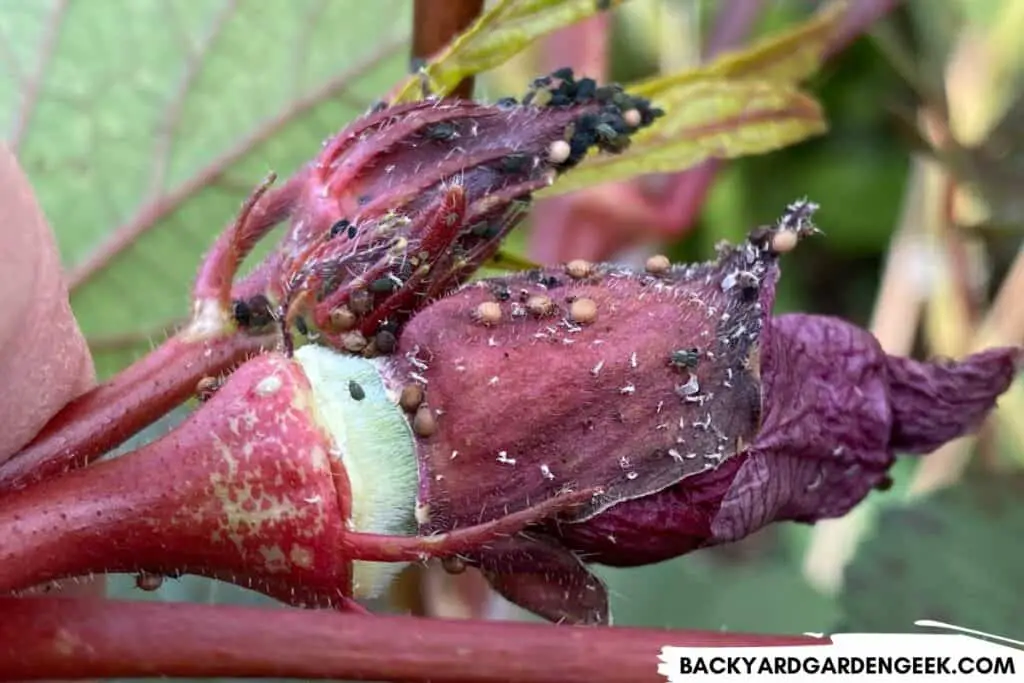
If your plant is covered in aphids, you obviously can’t rip off all the stems and leaves without hurting your plant, but you can carefully pull off some of the more heavily infested areas and get rid of them.
When it comes time to begin spraying your plants with water, soapy water, and neem oil, you’ll be able to spray more of the plant if those infested leaves have been removed and discarded.
2. Blast Leaves and Stems with Bursts of Water
As I’ve noted elsewhere, water is not very effective at getting rid of aphids, despite what you might see elsewhere on the internet, and rain or thunderstorms won’t wash aphids off your plants either.
But this is equally true: Strong sprays of water can knock back an infestation, at least a little bit. Unlike plants with more fragile foliage, okra can handle strong water blasts, so if you see aphids crawling on your okra, go ahead and blast them with a water hose.
Water won’t solve your problem–unlike some of the sprays I recommend below–but if you can kill off 10% or more of the aphids on your plants with a few simple sprays, you’ll be better off in the long run.
3. Watch Out for Aphid-Eating Bugs
Before you move on to soapy water and neem oil solutions, I recommend taking a very close look at your plants each day to see if any beneficial bugs have arrived.
Beneficial predators such as ground beetles, hoverflies, lacewings, ladybugs, parasitic wasps, and soldier beetles love a good aphid snack, and they’ll often be drawn to aphid infestations.
In fact, you sometimes don’t need to do anything when aphids arrive because the predatory bugs are so close on their heels.
This happened with some bean plants of mine last season. About a week or so after I noticed aphids, I saw all kinds of ladybugs around the plants, then ladybug larvae shortly after that.
Instead of spraying my plants with soapy water and neem oil sprays, which would have killed off all of the beneficial bugs, I let them do their work, and they took care of my infestation.
But this won’t always work, so you’ll have to keep a close eye on things. If the problem gets worse, you’ll need to get more aggressive to save your plants.
4. Use a Soapy Water Spray
In my opinion, the best, most effective, and most plant-friendly way to get rid of aphids on your okra is to begin spraying them with soapy water sprays on a near daily basis until the aphid infestation is gone.
Aphids are soft-bodied insects, and this means that soapy water will coat their exoskeletons in a filmy substance, choking them, drying them out, and killing them within a few hours.
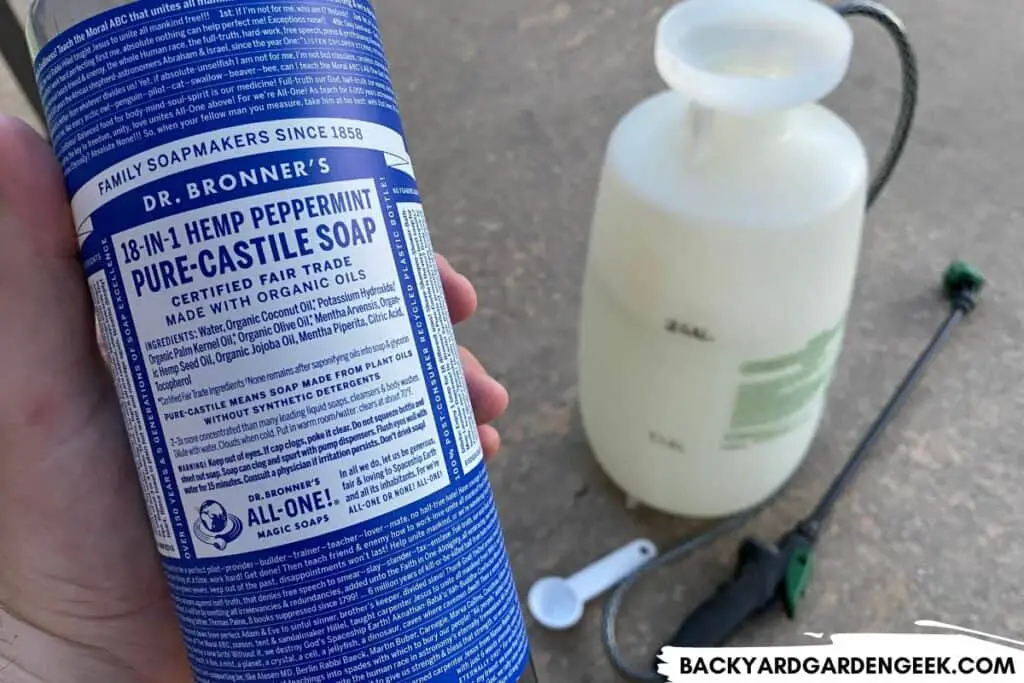
To make your own natural soapy water spray, follow these instructions:
- Fill a 2-gallon sprayer with water (7.5 L). I prefer 2-gallon sprayers because you can use them several days in a row without needing to mix a new batch.
- Add 4-5 tablespoons of castile liquid soap (15-30 ml). I prefer Dr. Bronner’s Peppermint Castile Soap, but you can use insecticidal soaps as well. Just follow the instructions on the insecticidal soap bottle so that you don’t harm your plants.
- Once you’ve added the soap to the water, shake well, then spray plants thoroughly, making sure to cover the bottoms of the leaves.
With extreme infestations, I get pretty aggressive with the soapy water sprays. I wait until the sun is setting, then spray my plants thoroughly. I’ll repeat the sprays every day for 1 week to ensure that I kill off both the mature aphids as well as any nymphs that have survived earlier sprayings.
5. Try a Neem Oil Spray
If I’m battling an aphid infestation with soapy water sprays, I like to add in a neem oil spray once every 4-7 days.
Unlike soapy water, which kills aphids but only on direct contact, neem oil sprays coats the plants’ foliage in neem oil, and neem’s primary chemical ingredient (azadirachtin) causes all kinds of biological havoc once aphids ingest it, killing them around 3-4 days later.
You’ll want to be careful when spraying your plants with neem oil because neem can burn or damage your plants if the sun rises before it’s fully dry.
I recommend spraying your plants with neem oil in the late afternoon, preferably as the sun is setting. This will give the neem oil spray plenty of time to dry before the sun rises the next day.
Here’s my recipe for a simple but effective neem oil spray:
- 1/2 gallon of water (1.9 liters). I like making enough for a 1/2 or 1-gallon sprayer. You don’t need to use a 2-gallon spray unless you’ve got a huge garden and a massive aphid problem.
- 1 tablespoon (15 ml) of neem oil. My favorites are Verdana and Neem Bliss.
- 2 teaspoons (10 ml) of castile liquid soap. I really like Dr. Bronner’s Peppermint Castile Soap.
You’ll only need to spray neem oil once every 4-7 days since it’s a longer-lasting insecticide than soapy water.
If you want to learn more about how I mix and use neem oil, check out these related articles:
- 9 Reasons Your Neem Oil Might Not Be Working
- How Can I Make Neem Oil More Effective? My 10-Step Process
- How Long Does Neem Oil Last? A Complete Shelf Life Guide
- Using Neem Oil Before a Harvest: The Do’s and Don’ts
- What Bugs Does Neem Oil Repel and Get Rid Of?
Will Aphids Hurt My Okra?
Aphids love okra, especially the developing buds that’ll produce flowers and seed pods.
The great thing about okra is that it’s an incredibly resilient plant and fairly resistant to aphid infestations since it’s got such hardy stems, leaves, and pods.
What aphids will do is this: They’ll seek out your plants, then cluster around the emerging flowers as they look for the plant’s phloem sap from one of the easier places to find it.
The good news is that your okra plants will hold up very well in the face of an aphid onslaught, well enough in case you’d like to give your garden’s natural predators time to intervene before turning to soapy water and neem oil sprays.
But don’t ignore a looming infestation just because okra plants happen to be hardy. Aphids not only feed on phloem sap. They’ll also pass along diseases from one plant to the next. Killing them off as quickly as possible will ensure that those aphids don’t continue to pass on diseases.
Getting Rid of Both Ants and Aphids on Your Okra
If you see ants on your okra, those ants are definitely not helpful.
Ants are actually there to protect the aphids so as to harvest the sugary honeydew droplets that aphids leave behind as byproducts of their feeding habits.

If you want to get rid of the ants, you need to first get rid of the aphids using my suggestions above.
There are different ways to get rid of ants on garden plants–including peppermint scents and essential oils (if you’ve got ants indoors)–but when it comes to okra, my go-to solution is a soapy water spray. It’ll kill off aphids as well as ants, practically any soft-bodied bugs that you spray it on directly.
Additional Information
If you’d like to learn more about how to handle aphid-related problems in your garden, check out these related articles:
